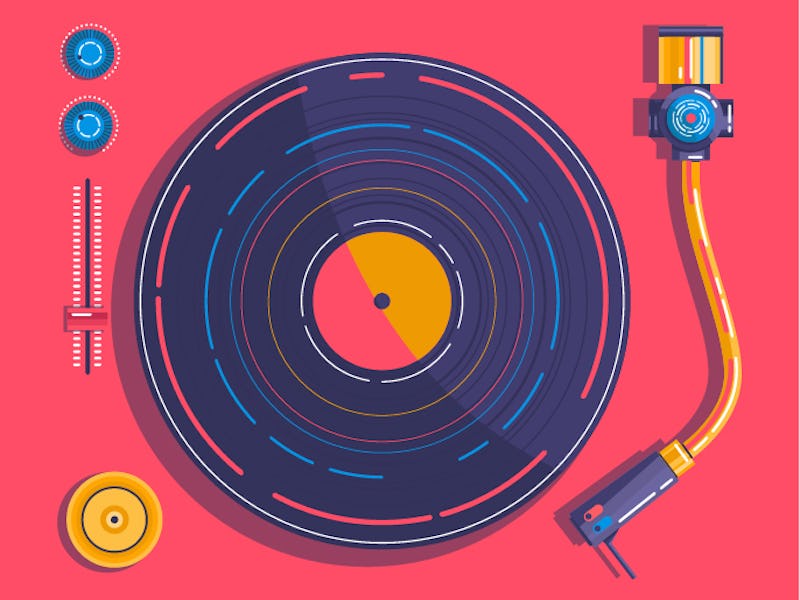Like many people across the world, this spring you may have traded your very adult apartment for your cluttered -- or redecorated -- childhood bedroom, as Covid-19 forced many young people back home to quarantine in the safer surrounds of family.
If those people headed to the basement for a brief escape from feeling like a child again, maybe they noticed their parents' record collection. While a few of those LPs had seen better days, the majority of those records might be relatively scratch-free.
A little more than a decade ago, these platters might've been a mystery, left sequestered in the basement, but as the gospel has spoken (again and again): vinyl is back! Heck, you probably even have your own collection that you schlepped back home to suburbia with you.
These music-filled discs have flown to outer space, outlived both the Walkman and the iPod, and now may be the last hope of bridging the generation gap with one's parents while holed up with them again. While they fought against obscurity well into the new millennium, these nostalgic music vessels have seen a resurgence that has brought them beyond the realm of hipster hobbyists, and into the mainstream, with major labels pumping out vinyl editions of albums by mainstream pop artists like Ariana Grande and Sam Smith.
While technology like the mp3 and streaming looked poised to send vinyl into extinction a decade ago, new innovation in record players and digital resources for fans have saved these antiques from obscurity. If anything, vinyl is now a token of one's appreciation as much as a vessel for the art.
THE ORIGIN — Coming off the Great Depression and heading into World War II, people were growing tired of only being able to listen to whatever music happened to be coming through their family's bookcase-sized radio.
Borrowing from older gramophone technology, record companies in the 1930s began manufacturing portable discs made from shellac (a brittle animal resin) and a plastic called polyvinyl chloride (aka, vinyl). They would engrave a few songs on it by making small grooves in the material. For decades, they thrived.
Quickly evolving music technology in the '80s nearly moved records into the discount bin of history.
THE TROUBLE — It began in the '80s with cassette tapes and then CD-playing Walkmen in the '90s, and finally the emergence of the iPod classic, in 2001.
While die-hards thought vinyl records had a better sound, the emergence of portable music offered something that vinyl never could: mobility. Why stay at home and listen to your albums on vinyl when you could take it with you?
To drive the comparison home, an 160 GB iPod Classic could hold 40,000 songs, the equivalent of over 3,000 vinyl records. These would weigh about 1,400 pounds.
Less than a million vinyl records were sold in the U.S. in 2006, compared to 39 million iPods worldwide.
But in just two years, the tide would begin to turn.
HOW TECH SAVED VINYL – In 2008, vinyl saw its first growth in sales since 1984 with an 89 percent increase in sales. For a music market that had been saturated with easy to find and listen to music, the thrill of sifting through what remained of records stores or your parents' collection offered a brief respite from the din of digital life.
While vinyl's return to stardom may have been based on nostalgia to start, technology quickly rose to the occasion to secure its place in the digital world. Companies like Crosley began designing Instagram-friendly record players and records started cropping up again not only in music stores but on Amazon and at mall stores frequented by college students, like Urban Outfitters.
And with people's growing collections of physical vinyl came a growing need to digitally organize it. oNline hubs like Discogs, which was launched in 2000 but gained popularity and capability in recent years, were designed to do just that. The site (and app) allows users to directly scan information about their records and more easily sift through their collection without putting the physical records themselves in harm's way. Crucially, it's also a second-hand market for buying records.
The last two years have also seen a new kind of vinyl itself emerge: HD vinyl. Reports The Verge: HD vinyl works by converting audio first to a 3D topographic map and then stamping this map onto a vinyl disc. Using this method the creators say that records could have 30 percent more song space, 30 percent louder sound, and more authentic sound quality.
THE FUTURE – How long will this new vinyl enthusiasm last? Who can say. But for now, we can be thankful for the ways this technology has adapted to our new digital habits. And for how it still allows us to connect across generations, especially in times when we need to the most.
HOW TECH SAVED is an occasional series from Inverse that explores how technology saved something that's great. Have a suggestion for a future How Tech Saved story? Let us know here using this form.
